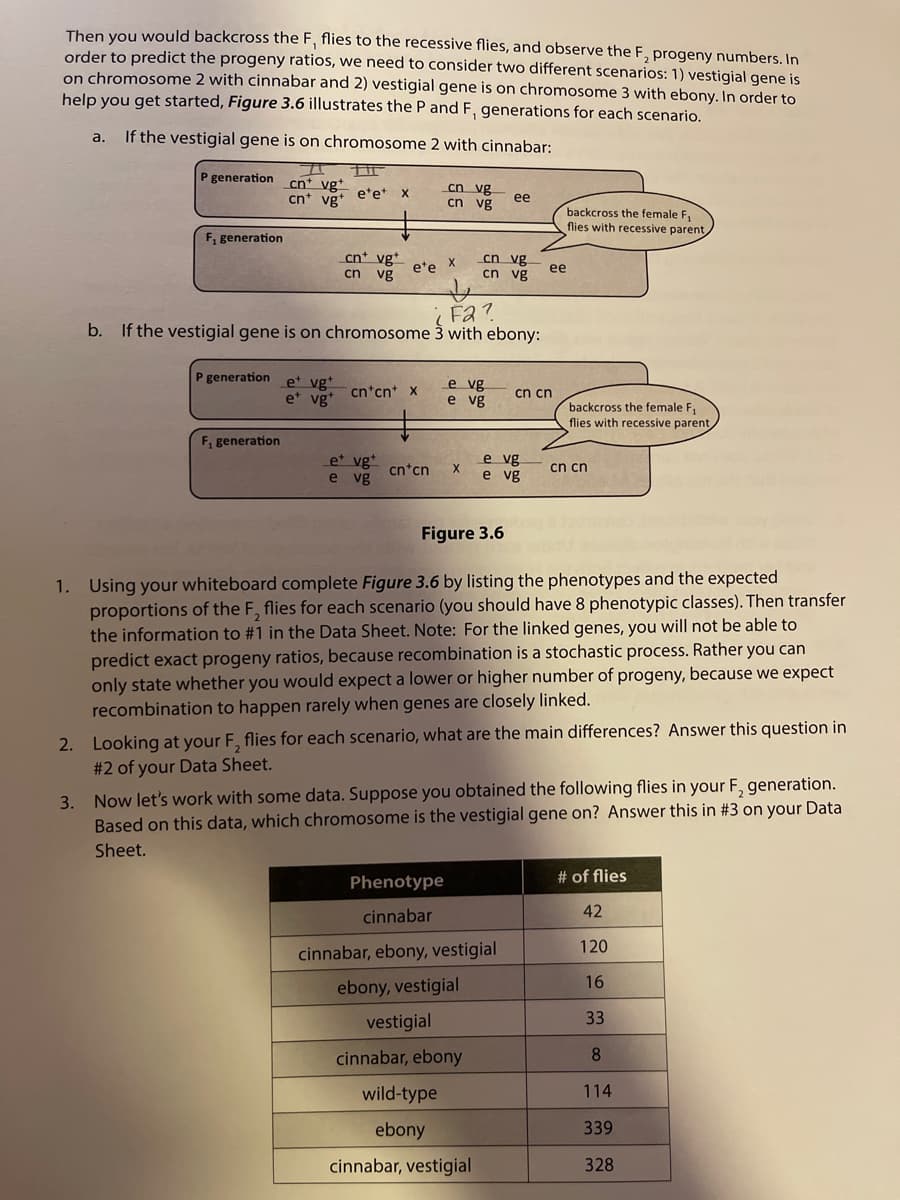Human Heredity: Principles and Issues (MindTap Course List)
11th Edition
ISBN:9781305251052
Author:Michael Cummings
Publisher:Michael Cummings
Chapter15: Genomes And Genomics
Section: Chapter Questions
Problem 2QP: Hemophilia and color blindness are both recessive conditions caused by genes on the X chromosome. To...
Related questions
Question
Questions
![1. List the phenotypes and expected proportions of the F, flies from Exercise II.
Scenario 1: vestigial gene is on chromosome 2
Nonrecombinant
DnenotyPe
Recombinant
DhenotyRe
[Cht vgte] wild type
[ cntvgte] E bony
Ccn Vg e] Cinnabar, vegista l
Centvget] vegięteal
Cinnabor, vegistal, ebony
Scenario 2: vestigial gene is on chromosome 3
2. What are the main differences between the two scenarios regarding the F, flies?
3. Which chromosome is the vestigial gene on?](/v2/_next/image?url=https%3A%2F%2Fcontent.bartleby.com%2Fqna-images%2Fquestion%2Fc6184893-1e67-4ed8-9784-fdd0cf2ed60a%2F97c811e6-81d4-4747-b60e-056eba6fca8e%2F98fp01a_processed.jpeg&w=3840&q=75)
Transcribed Image Text:1. List the phenotypes and expected proportions of the F, flies from Exercise II.
Scenario 1: vestigial gene is on chromosome 2
Nonrecombinant
DnenotyPe
Recombinant
DhenotyRe
[Cht vgte] wild type
[ cntvgte] E bony
Ccn Vg e] Cinnabar, vegista l
Centvget] vegięteal
Cinnabor, vegistal, ebony
Scenario 2: vestigial gene is on chromosome 3
2. What are the main differences between the two scenarios regarding the F, flies?
3. Which chromosome is the vestigial gene on?

Transcribed Image Text:Then you would backcross the F, flies to the recessive flies, and observe the F, progeny numbers. In
order to predict the progeny ratios, we need to consider two different scenarios: 1) vestigial gene is
on chromosome 2 with cinnabar and 2) vestigial gene is on chromosome 3 with ebony. In order to
help you get started, Figure 3.6 illustrates the P and F, generations for each scenario.
If the vestigial gene is on chromosome 2 with cinnabar:
a.
P generation
cn* vg*
ete*
cn vg*
cn vg
cn vg
ее
backcross the female F,
flies with recessive parent
F, generation
cn* vg*
e*e
cn vg
cn vg
cn vg
ее
Fa?
b. If the vestigial gene is on chromosome 3 with ebony:
generation
et vg*
et vg*
e vg
e vg
cn*cn+ x
cn cn
backcross the female F,
flies with recessive parent
F, generation
et vg*
e vg
e vg
e vg
cn*cn
cn cn
Figure 3.6
1. Using your whiteboard complete Figure 3.6 by listing the phenotypes and the expected
proportions of the F, flies for each scenario (you should have 8 phenotypic classes). Then transfer
the information to #1 in the Data Sheet. Note: For the linked genes, you will not be able to
predict exact progeny ratios, because recombination is a stochastic process. Rather you can
only state whether you would expect a lower or higher number of progeny, because we expect
recombination to happen rarely when genes are closely linked.
2. Looking at your F, flies for each scenario, what are the main differences? Answer this question in
#2 of your Data Sheet.
3. Now let's work with some data. Suppose you obtained the following flies in your F, generation.
Based on this data, which chromosome is the vestigial gene on? Answer this in #3 on your Data
Sheet.
Phenotype
# of flies
cinnabar
42
120
cinnabar, ebony, vestigial
16
ebony, vestigial
vestigial
33
cinnabar, ebony
8
wild-type
114
ebony
339
cinnabar, vestigial
328
Expert Solution
This question has been solved!
Explore an expertly crafted, step-by-step solution for a thorough understanding of key concepts.
This is a popular solution!
Trending now
This is a popular solution!
Step by step
Solved in 2 steps

Recommended textbooks for you

Human Heredity: Principles and Issues (MindTap Co…
Biology
ISBN:
9781305251052
Author:
Michael Cummings
Publisher:
Cengage Learning

Concepts of Biology
Biology
ISBN:
9781938168116
Author:
Samantha Fowler, Rebecca Roush, James Wise
Publisher:
OpenStax College

Human Heredity: Principles and Issues (MindTap Co…
Biology
ISBN:
9781305251052
Author:
Michael Cummings
Publisher:
Cengage Learning

Concepts of Biology
Biology
ISBN:
9781938168116
Author:
Samantha Fowler, Rebecca Roush, James Wise
Publisher:
OpenStax College